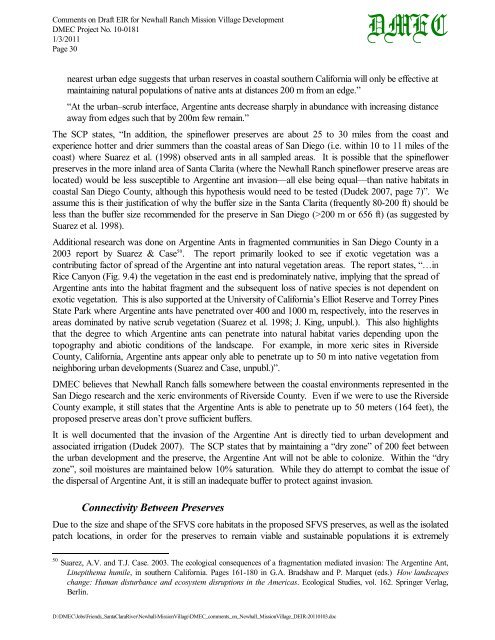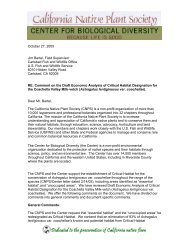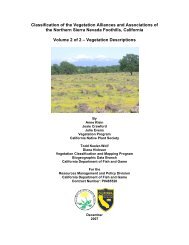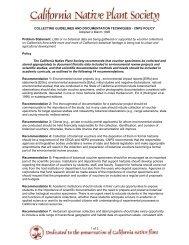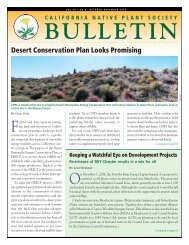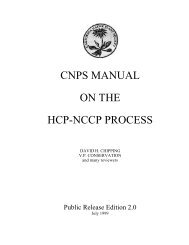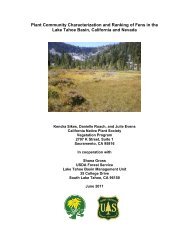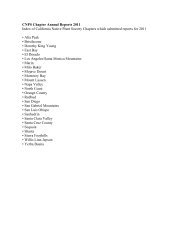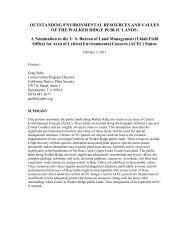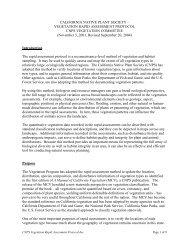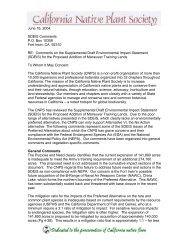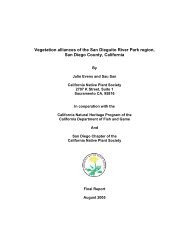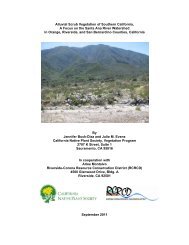David Magney Environmental Consulting - California Native Plant ...
David Magney Environmental Consulting - California Native Plant ...
David Magney Environmental Consulting - California Native Plant ...
Create successful ePaper yourself
Turn your PDF publications into a flip-book with our unique Google optimized e-Paper software.
Comments on Draft EIR for Newhall Ranch Mission Village Development<br />
DMEC Project No. 10-0181<br />
1/3/2011<br />
Page 30<br />
D:\DMEC\Jobs\Friends_SantaClaraRiver\Newhall-MissionVillage\DMEC_comments_on_Newhall_MissionVillage_DEIR-20110103.doc<br />
DMEC<br />
nearest urban edge suggests that urban reserves in coastal southern <strong>California</strong> will only be effective at<br />
maintaining natural populations of native ants at distances 200 m from an edge.”<br />
“At the urban–scrub interface, Argentine ants decrease sharply in abundance with increasing distance<br />
away from edges such that by 200m few remain.”<br />
The SCP states, “In addition, the spineflower preserves are about 25 to 30 miles from the coast and<br />
experience hotter and drier summers than the coastal areas of San Diego (i.e. within 10 to 11 miles of the<br />
coast) where Suarez et al. (1998) observed ants in all sampled areas. It is possible that the spineflower<br />
preserves in the more inland area of Santa Clarita (where the Newhall Ranch spineflower preserve areas are<br />
located) would be less susceptible to Argentine ant invasion—all else being equal—than native habitats in<br />
coastal San Diego County, although this hypothesis would need to be tested (Dudek 2007, page 7)”. We<br />
assume this is their justification of why the buffer size in the Santa Clarita (frequently 80-200 ft) should be<br />
less than the buffer size recommended for the preserve in San Diego (>200 m or 656 ft) (as suggested by<br />
Suarez et al. 1998).<br />
Additional research was done on Argentine Ants in fragmented communities in San Diego County in a<br />
2003 report by Suarez & Case 50 . The report primarily looked to see if exotic vegetation was a<br />
contributing factor of spread of the Argentine ant into natural vegetation areas. The report states, “…in<br />
Rice Canyon (Fig. 9.4) the vegetation in the east end is predominately native, implying that the spread of<br />
Argentine ants into the habitat fragment and the subsequent loss of native species is not dependent on<br />
exotic vegetation. This is also supported at the University of <strong>California</strong>’s Elliot Reserve and Torrey Pines<br />
State Park where Argentine ants have penetrated over 400 and 1000 m, respectively, into the reserves in<br />
areas dominated by native scrub vegetation (Suarez et al. 1998; J. King, unpubl.). This also highlights<br />
that the degree to which Argentine ants can penetrate into natural habitat varies depending upon the<br />
topography and abiotic conditions of the landscape. For example, in more xeric sites in Riverside<br />
County, <strong>California</strong>, Argentine ants appear only able to penetrate up to 50 m into native vegetation from<br />
neighboring urban developments (Suarez and Case, unpubl.)”.<br />
DMEC believes that Newhall Ranch falls somewhere between the coastal environments represented in the<br />
San Diego research and the xeric environments of Riverside County. Even if we were to use the Riverside<br />
County example, it still states that the Argentine Ants is able to penetrate up to 50 meters (164 feet), the<br />
proposed preserve areas don’t prove sufficient buffers.<br />
It is well documented that the invasion of the Argentine Ant is directly tied to urban development and<br />
associated irrigation (Dudek 2007). The SCP states that by maintaining a “dry zone” of 200 feet between<br />
the urban development and the preserve, the Argentine Ant will not be able to colonize. Within the “dry<br />
zone”, soil moistures are maintained below 10% saturation. While they do attempt to combat the issue of<br />
the dispersal of Argentine Ant, it is still an inadequate buffer to protect against invasion.<br />
Connectivity Between Preserves<br />
Due to the size and shape of the SFVS core habitats in the proposed SFVS preserves, as well as the isolated<br />
patch locations, in order for the preserves to remain viable and sustainable populations it is extremely<br />
50 Suarez, A.V. and T.J. Case. 2003. The ecological consequences of a fragmentation mediated invasion: The Argentine Ant,<br />
Linepithema humile, in southern <strong>California</strong>. Pages 161-180 in G.A. Bradshaw and P. Marquet (eds.) How landscapes<br />
change: Human disturbance and ecosystem disruptions in the Americas. Ecological Studies, vol. 162. Springer Verlag,<br />
Berlin.


